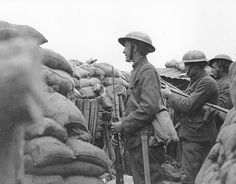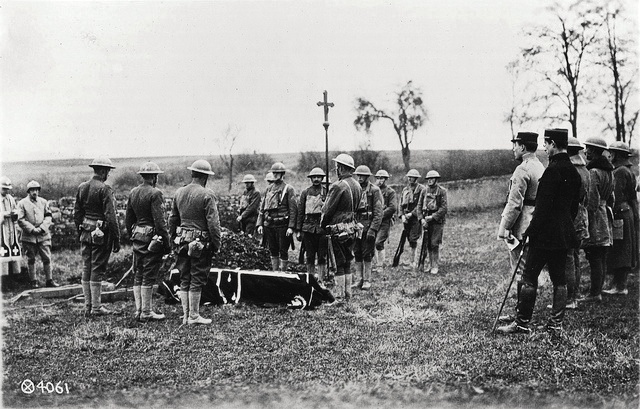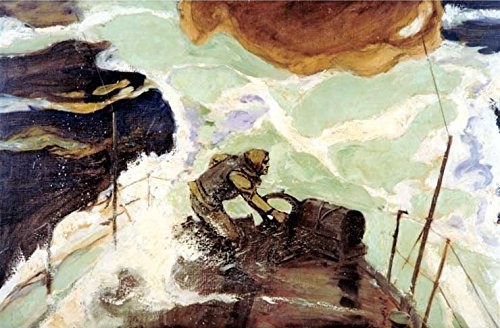In the summer and fall of 1917, American Expeditionary Forces commander John J. Pershing, now a four-star general, was building an army in France. He began in June with a small advance staff and by August had assembled enough soldiers for one division, the U.S. First Infantry, known to history as The Big Red One.
By the end of 1917 Pershing would have most of four infantry divisions in France. This was not enough to make much of an impact at the front against the Germans. However these first fighters, a combination of regular army and national guardsmen together with a brigade of U.S. Marines, blazed a trail for all Americans who would fight in France.

“Duty First”
The 16th U.S. Infantry Regiment was one of the first American fighting units to reach France in June 1917. It was the 16th Regiment’s Second Battalion who made the famous July 4th march through Paris. From July to October the 16th Regiment trained with other regiments of the Big Red One in rural France. Although they were a Regular Army unit whose heritage went back to the Civil War, in fact many of the 16th Infantry were new recruits.
The Americans stayed in a training area with an experienced French division and learned how to fight a modern war in large formations. There they practiced trench warfare, gas mask drills and worked together with artillery units in exercises.
The goal was to enter the war as a freestanding American force that could hold, fight and win on the Western Front. But their training at home had been basic. Now they were learning from veterans who had seen it all.

Experiencing the Front
The German line first received notice from American arms at 6:05 a.m. on October 23, 1917. That’s when the cannon of Battery C, 6th Field Artillery Regiment of the Big Red One fired their first shots into German-held territory. Since October 21, 1917 American units were entering the trenches at the front line.
After months of training behind the lines, introduction to actual combat operations was intended to be gradual. American battalions would occupy one sector between French battalions, under French command. Only one battalion each from the four Infantry regiments would serve at a time, and then withdraw to be replaced by another American battalion. Moreover, the sector the Americans held was quiet.
Quiet on the Western Front was shattered on the night of 2-3 November 1917 when a company of the 7th Bavarian Landwehr Regiment, in a coordinated attack with German artillery, isolated and entered the American line held by Second Battalion, 16th U.S. Infantry.
In just minutes of savage fighting, the Bavarians made off with eleven prisoners and their weapons. They left behind seven Americans wounded and three Americans dead. Corporal James Gresham, Privates Merle Hay and Thomas Enright, all of Company F, were the first in American uniform to die in combat on the front line. The sector they held, near Bathelémont, hadn’t seen serious fighting since October 1915 and was considered quiet.

The morning after
While the Germans celebrated their raid on the inexperienced Americans, they too had left behind two of their dead and one German who deserted. Additionally seven of the German raiders were wounded. The Americans on the front line did not break and run, as so many in Germany had predicted.
Firsthand experience of close combat was a sobering moment for the First Infantry. They buried their dead that afternoon, November 3rd, in Bathelémont. The policy of sending battalions to the front line was reassessed and the 2nd Battalion was withdrawn later that month, on November 20th. Corporal Gresham, Private May and Private Enright each posthumously received the Croix de Guerre from the French nation.
Queenstown, Ireland
The first six American Navy destroyers arrived in Queenstown on May 4, 1917. Almost immediately they began patrolling the Western Approaches to the British Isles. Then six ships of Destroyer Division Seven arrived on May 17. By the fall about 37 U.S. Navy destroyers and a number of support ships were based in Queenstown. The destroyers guarded convoys inbound to the British Isles and France and made antisubmarine patrols.
On October 15, 1917 the destroyer USS Cassin was patrolling near Mine Head, Ireland when it sighted German submarine U61. Cassin gave chase, but soon a torpedo was sighted heading toward the destroyer. Cassin tried to evade the torpedo, but it looked as though it would hit the stern of the destroyer.
At that moment Gunner’s Mate 1st Class Osmond Ingram ran aft to release Cassin’s depth charges before the impact destroyed the ship. Before all the charges could be released the torpedo hit, blowing the stern off the destroyer.
GM1 Ingram’s quick thinking saved his ship but cost him his life. Nine other sailors were wounded and one officer later died of complications from exposure. But the Cassin made it back to Queenstown and was eventually repaired. Gunner’s Mate 1st Class Ingram was the first American sailor to die in combat in World War I. He was posthumously awarded the Congressional Medal of Honor (see GM1 Osmond ingram’s Medal of Honor citation here).

